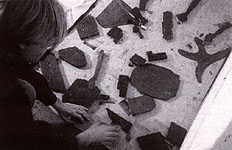
CLICK HERE TO VIEW SELECTION OF PRINTS
 Matthias Mansen
Matthias Mansen
(German, b. 1958)
Matthias Mansen was born in Ravensburg, Baden-Wurtemberg, in southern Germany, in 1958. From 1978-1984 he trained as a painter at the Karlsruhe Akademie under Markus Lupertz but turned to woodcut while still a student.
Mansen's first woodcut, made in 1983, was Stuhl, a study of a chair as a stark silhouette printed in green. Zimmer, also from 1983, which won him a prize from the Landesbank Stuttgart, similarly showed isolated objects in a roomlike expanse of paper. At 25, Mansen was the youngest artist included in the 1984 Stuttgart woodcut survey Der deutsche Holzschnitt im 20. Jahrhundert.
His print, Der Tod und des Madchen, referred to the allegory so often depicted in German art. Mansen never returned to such a traditional theme, but the print remains a "touchstone" for him because of the way it was made. "I found this planking board on the street, as I still do get all my wood. The paper I printed on was newsprint, cheap from a roll, no limitations in size, and beautiful to print by hand. I used oil color, bright but matte, available in all shades, easy to mix and dilute, and I already had them for my painting. To cut the bloc, I used sculptor's printmaking as a process, to let the work and its development take on a life of their own, not as a means to create identical images."
In 1989, Mansen moved to Brooklyn. He decided to place figures in a clearer context-a very everyay place-a bathroom. After he did the six-state Badezimmer, he says, "It slowly occured to me that I could do more of the individual rooms of a house. I'm not entirely clear why. It had something to do with feeling I had to assert myself, to realize what I had accomplished so far. The domestic imagery seemed basic-I had done so much-but I also wanted to work in what I'd done since 1983, the progressive series in Berlin, the nuances of color in England, the sense of inside/outside in Paris, the discoveries of Begegnung. I wanted an overall structure so I could work freely and develop from there."
Later, Mansen introduced new elements to his Das Haus narrative, setting up a rhythm-a door to separate the rooms, and a green chair, cut like a puzzle piece and printed various directions, a quite conscious allusion to his first print. For me, Mansen sums up, "the themes that culmiate in Das Haus develop like a snail's house, in a way. When I did my first woodcut, it was about creating space by using individual objects, and later I introduced patches of light, and then created almost a narrative with the Essen prints, a very simple narrative that grew and grew, and I ended up with Das Haus, which includes as much as possible all these images, even my first print."
(Excerpt from "About Matthias Mansen: A Story" by Jacqueline Brody. Art on Paper, Nov/Dec 1998. Click HERE to order the past issue.)
Works in Public Collections in the US:
The Baltimore Museum of Art, Baltimore
Museum of Fine Arts, Boston
The Museum of Modern Art, New York
National Gallery of Art, Washington